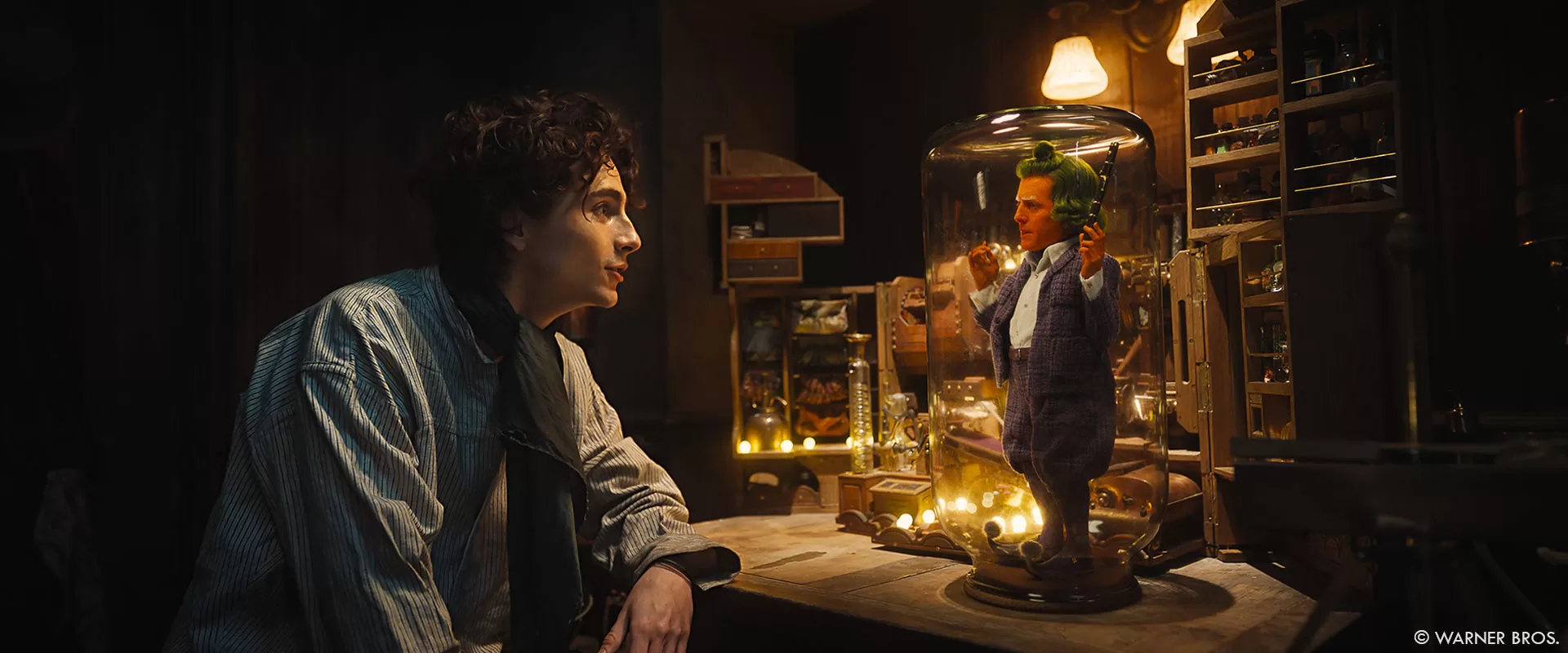In 2023, Graham Page presented the work of Framestore on The Matrix Resurrections. Today, he returns to discuss his role as Overall VFX Supervisor on Wonka.
With over 25 years’ experience in visual effects, Robert Allman has made his mark working for studios such as Mill Film, Prime Focus and Framestore. His impressive portfolio includes films such as Gladiator, Alien: Covenant, Dolittle and The Little Mermaid.
Carlos Monzon began his career in visual effects in 2001 when he joined the Buzz Image team. His career led him to work with several studios, including Meteor Studios, ILM and MELS, before joining Framestore in 2013. He has worked on shows such as Avatar, Paddington, The Martian and Don’t Look Up.
What was your feeling about this new collaboration with Director Paul King?
Graham Page (GP) // Working with Paul was great; he has lots of ideas and a fantastic eye for detail. He’s always trying to bring out as much humour as possible into every shot so there’s lots of fun involved, but he’ll always push very hard to get the best result possible as well.
Robert Allman (RA) // Paul really believes CG in visual effects is a pivotal part of the filmmaking process and as such he should be every VFX artist’s dream to work with! He has great respect for us and what we do and that is why the VFX in his films are always so great.
Carlos Monzon (CM) // I had the pleasure of working with Paul on Paddington 1 & 2. Collaborating with him Wonka was great, he understands the value of the work we do and really helped us achieve the best results for his movie.
What was his approach and expectations about the visual effects?
GP // Having made the Paddington films, Paul has a fantastic understanding of VFX. He knows what is achievable and what the bigger challenges are. He was very keen to create realistic environments rather than anything too stylized or fantastical. Paul has a big fondness for animation so he loved working with our animation supervisors, Dale Newton and Meena Ibrahim, on creating the various creature performances in the films. He appreciated our approach which was always to try to ground the creatures in real world references.
RA // I think he always thought ahead that his shots could be perfected in CG, from everything from animated performance to smoothing out live action camera moves if the cranes etc. hadn’t quite given him what he wanted. The leap of faith he took in going for a fully CG Oompa Loompa, given the level of realism needed, was incredibly brave. Again, it really paid dividends and I hope we did that decision justice.
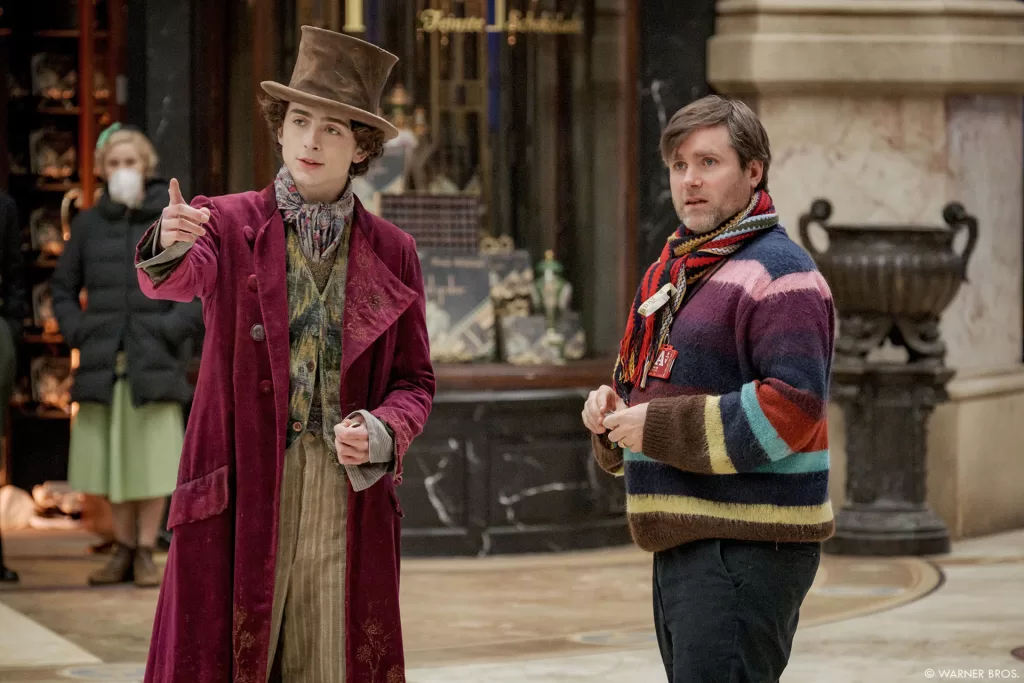
How did you organise the work with your VFX Producer?
RA // The decision was taken to put the Oompa Loompa in our London studio owing to the concentration of animators here and also that the follow up Hugh sessions would be done in London. The other work was more or less overflow from what Montreal was doing.
CM // Early on it was decided that the Montreal studio would take care of a large portion of the set extensions and creatures. Focusing mainly on the design of the Town Square, Zoo, Scrubbit & Bleachers, Galeries Gourmet and Abigail, the Giraffe.
Where were the various sequences of the movie filmed?
GP // Much of the film was shot at Warner Brothers studios in Leavesden UK but we also went to a number of locations around the UK. We shot the interior of the Cathedral in St Paul’s in London, it was incredible to see it all beautifully lit with 100’s of stunt monks running through and Rowan Atkinson being chased by a full scale giraffe Puppet.
Oompa Loompa land was filmed in Wales at Church Door Cove in Wales, just as we were about to start to shoot, Timmy Mallett arrived to go for a morning swim and we had to wait for him to swim off, out of shot. The background plate for Wonka walking up the beach to collect Cocoa beans was the first footage shot on the film with an element of Timothée Chalamet shot later at Leavesden.
The exterior of the zoo was shot in St Albans, north of London.
We also shot in Bath and Oxford and Wonka’s arrival to the dock of the Grand City was filmed in Lyme Regis. Large crowds turned out to watch the filming and our reference chrome ball drew attention with someone shouting loudly. ‘He’s got a Lolly Pop! He’s got a Lolly Pop!’
Can you elaborate about the design and creation of the various environments?
GP // Much of the design was started in pre-production by the art department who designed the sets and how they would be extended later, this design process carried into post with us refining and adding to these designs, both in terms of fleshing out the required details but also working the roof top designs to make sure they felt natural and also worked for shots where we are above them.
RA // I would echo what Graham has said. There was a lot of overhauling the design of the city in the wide shots, Paul really wanted a sense of reality to it, as if you felt you could take a holiday there. Planning and referencing real world scans of actual old towns was key.
What was the real size of the sets?
GP // The sets, brilliantly created by production designer Nathan Crowley were pretty huge. The Galleries set was connected to the town square allowing for shots crossing the threshold between the interior and exterior world. However, they generally stopped short at about 30 to 40 foot high and we needed to extend the tops of them. Painted backdrops were used in the townsquare down alleyways to provide naturalistic reflections for vehicles and reduce blue spill, these were then rotoscoped to allow them to be replaced with deeper 3d extensions.
Wonka’s chocolate shop used pretty much all of one of the biggest stages at Leavesden and involved a huge revolving tree and travelling chocolate river and candy boat. We enhanced this set with extra details such as the chocolate bunnies and owl and growing flowers. We also created the world above the canopy of the tree based on a theatrical backstage area with ropes and pulleys to control the floating clouds and rainbows.
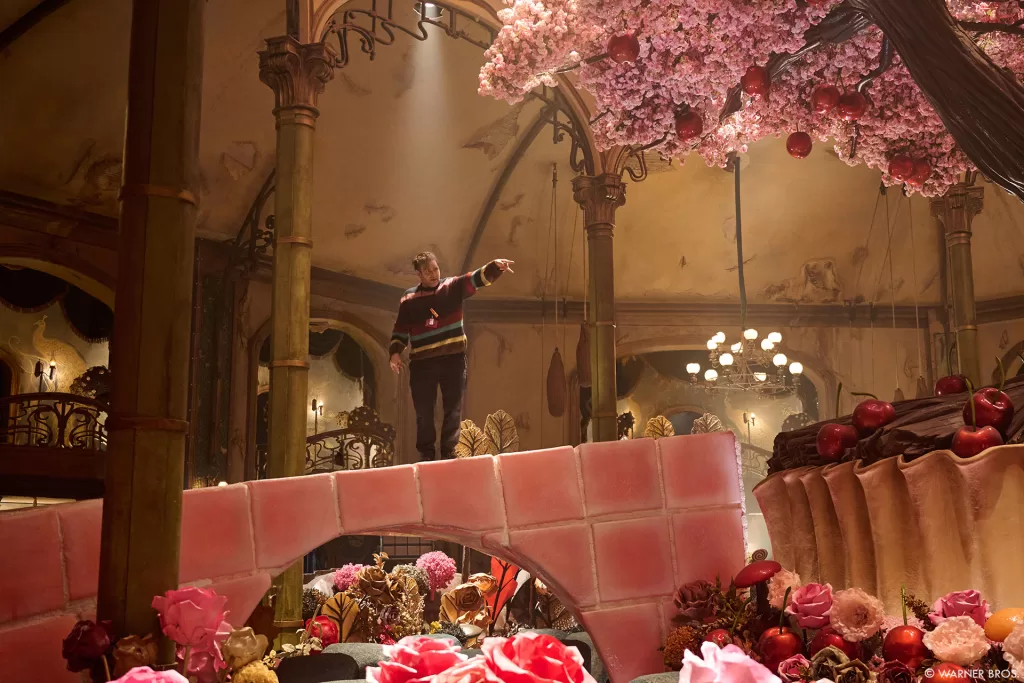
What kind of references and influences did you receive for the environments?
GP // The film is set in a story book world with many influences taken from all over Europe. Before filming ended up in Leavesden the production had considered finding a real town square to film in such as the Grand-Place in Brussels but instead details were cherry picked from the best of these real world locations. The Galleries Gourmet interior is largely based on Galleria Vittorio Emanuele II in Milan. The powder gate tower in Prague features, along with various astronomical clocks and statues. The zoo draws influences from zoos in Berlin, Antwerp, New York and London amongst others.
RA // I would add Oxford to what Graham says about the Grand Old City. There was much talk about different districts and the university district was very much based on that.
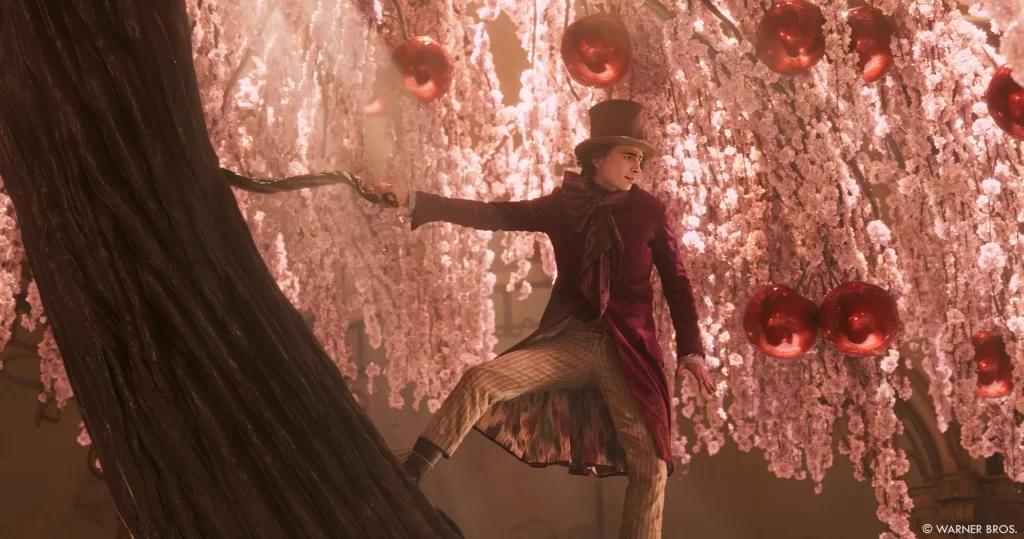
Which location was the most complicated to create?
GP // The city and rooftop environment seen when Wonka and Noodle dance on the roof was hard to create as it needed to include lots of detail both near and far. With the Galleries roof in particular being difficult to design. The scene needed to look beautiful but also stay grounded in reality so we needed to balance the realities of street design while maintaining compositions which felt grand and effectively told the story of their travel from the zoo to the town square.
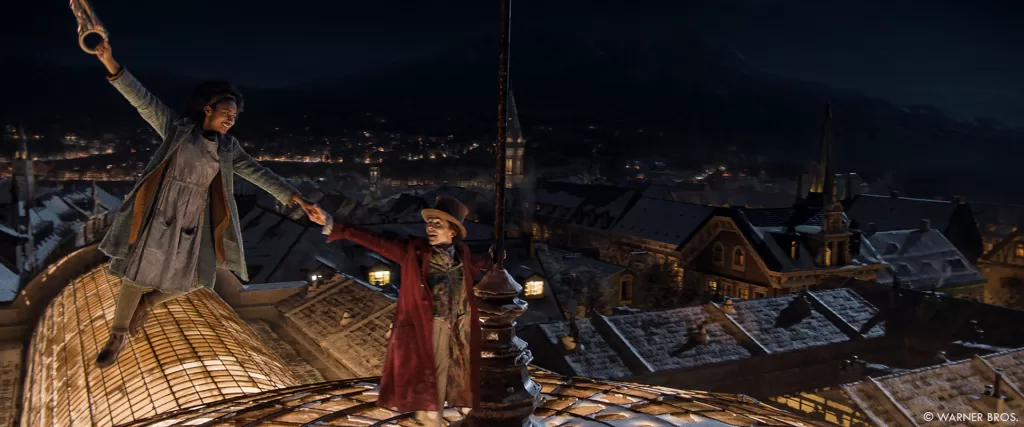
Can you explain in detail about the creation and animations of the animals and especially the giraffe?
CM // Asset Creation: Based on references provided by Framestore’s Capture Lab our asset team created 3D replicas of the Flamingos and Giraffe. Our models were modelled and rigged based on real life anatomy to define the bones and joints placements to have the animals correct range of motion.
During the asset creation the animation team under the Supervision of Meena Ibrahim started running tests to explore the physicality and different actions the animals could achieve. We made sure we could match exactly the interesting structure and behaviour of a real giraffe, in addition to the subtle facial performance to the finest detail tested the Giraffe and Flamingos.
The team also collected a large amount of video references that allowed us to match the behaviour of the real giraffe. The same references provided a target for the CFX team to match and build their rigs. The skin, muscle and fat simulations gave the giraffe a realistic look and feel. Once the tests were lit and comp onto a plate, it was almost impossible to tell the difference between the reference and our CG animated version .
Animation: The main challenge the animation team faced was to make the giraffe move in a believable manner, while still achieving the performance Paul wanted for the movie. In order to do this we had to gather even more references from all over the internet, as well as getting some acting references from Paul King during our client reviews. The team did keyframe animation for all the shots that involved a Giraffe, dog or a flamingo and based their animation on real references.
We see the giraffe in various close up shots. How did you handle this challenge?
CM // Based on early storyboards of the movie, we knew our asset would require a tremendous amount of detail to hold up really close to the camera. Framestore’s Capture Lab provided extensive footage and photographs of a real giraffe named Molly, from the London Zoo. This enabled the team to meticulously align our 3D assets to the references and create a 1 to 1 match. We had to create two variants of the giraffe, one that was used for most shots and another one that was built for all the closeups. This variant was a higher resolution model, used larger maps and had much more density for the giraffe’s groom.
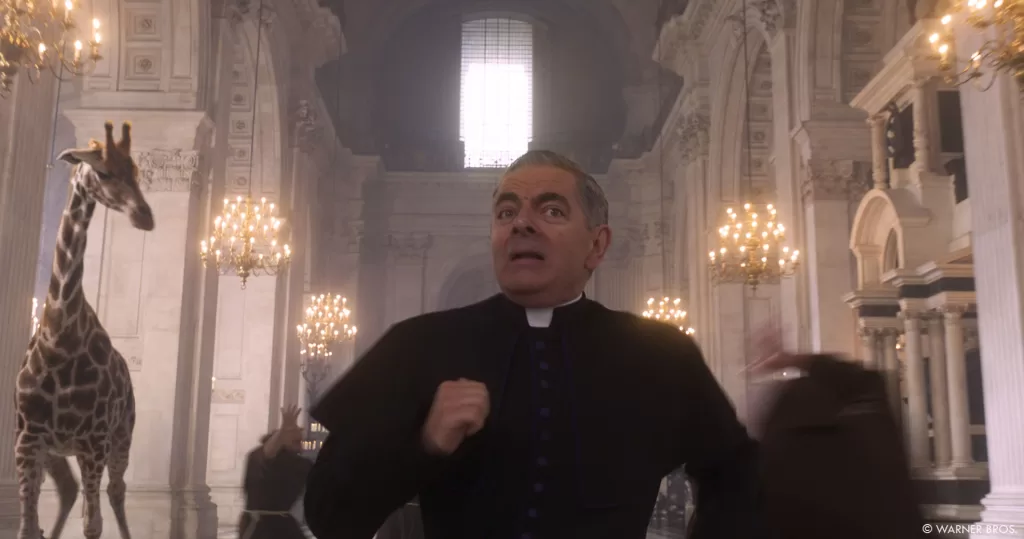
How did you manage the interactions with the giraffe and the actors?
CM // On set puppets and eye line poles were used to interact with the actors. The live action footage required precise matchmove of the actors hands and fingers to create a flawless interaction between the CG and the actors. A handful of shots required us to fully replace the actors hands with CG, this allowed us to get a better interaction between the fingers and the fur.
Let’s talk about the impressive Oompa-Loompa. What was your approach for this character?
RA // After many different iterations at the concept stage, Paul arrived at the simplest explanation, that he was just a small Hugh Grant. From that moment, we were locked into achieving a high degree of detail in the facial performance but also resolving the classic look of the Oompa Loompa in that context. The costume designers made tiny costumes so we had a clear idea of the wardrobe of this stylishly turned out individual, which underlay the cool and capable side of his character.
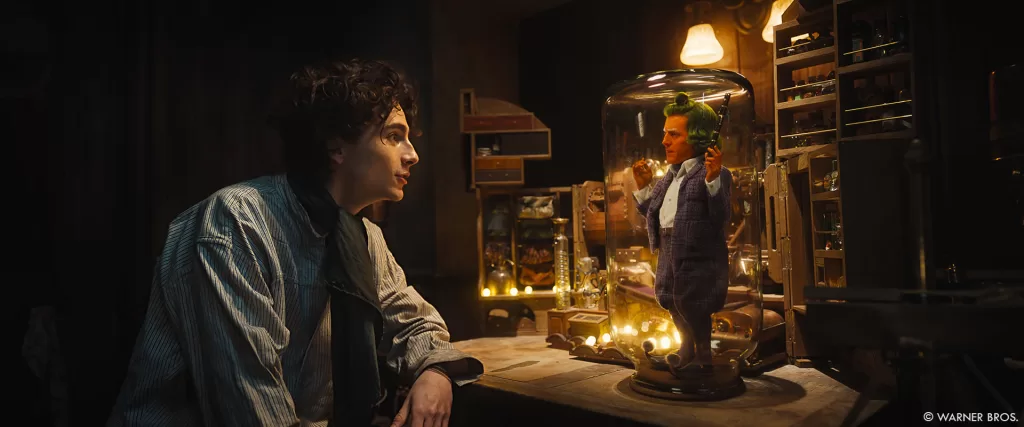
Can you elaborate on his design and creation?
RA // We were half referencing the books, where the Oompa Loompas are tiny elf like creatures and half referencing the classic look from the Gene Wilder version of the film, green bobbed quiff, orange skin and white eyebrows. With this sort of comic appearance it became a huge challenge to keep it looking like Hugh. That could only be solved by scrutinising his every facial movement.
Can you tell us more about the animation challenges?
RA // The performance ended up being completely hand animated, mainly because we were dealing with exaggerated comic acting, something that is very difficult to get out of a more procedural, motion captured method. So much of a very expressive performance is subjective that it is really impossible to do it without an animator and sculptor resolving it subjectively.
How does his orange and green colour affect your work?
GP // The colours did offer their own challenge as Paul wanted them to be as vibrant as possible but particularly with the skin you’re limited with how much red can be pushed into the skin before the colour begins to look oversaturated and in some cases break out of the colour gamut. Similarly the green hair had to look like real hair not a plastic wig so a lot of effort was placed on getting variation within the colour and size of the strands.
RA // Yes, in many ways the worst possible scenario for a CG character who has to look real; bright orange and green! But that was a big part of the comedy, so the challenge was worth it. Lighting became very important as to make him look natural, you have to put more cool colour in the shadows than you would normally. The challenge was then that that would instantly break in a new sequence where the lighting was different. We were always starting again, the rebalancing was very tricky.
Can you explain in detail about the shooting and creation of the beautiful final sequence where we see the old castle turning into the chocolate factory?
GP // We found a great castle called Bodiam Castle in East Sussex which felt like a really good fit to create the factory within. The walls provided a great call back to the ruined stone walls we see in the 1970s film when we see Wonkas ‘world of Pure Imagination’ which we spent time analysing to try to recreate the look and feel.
The design was based around steam fairs and breweries for the mechanisms but also children’s playgrounds and swimming pools for elements of fun and vibrant colours. Jonathan Opgenhaffen designed the interior to have a logic and sense of flow in terms of how the chocolate powered the water wheel which in turned cogs and wheels around the factory.
Which sequence or shot was the most challenging?
GP // The first shot of Wonka climbing the mast was particularly difficult.
RA // Always the Oompa Loompa. The level of work needed to perfect the performance, the amount of animation, the lighting and look was as hard as it can be.
CM // During one of the musical numbers, there is one shot where the camera is flying over the plaza and hundreds of extras running towards Wonka. The shot is composed of over 11 plates that were conformed together to populate the town square with customers. This was an extremely complicated comp to achieve.
Is there something specific that gives you some really short nights?
RA // The chocolate factory was late in the schedule and when I worked out on the back of a beer coaster how many weeks we had left against the number of available machines to render everything, I immediately returned to the bar for another drink. And then quite a few more.
What is your favourite shot or sequence?
RA // The first close up look of the Oompa Loompa. We developed everything in that shot, so it must have taken a year and a half. Normally, the development shot is one of the worst, as you never revisit it and it doesn’t benefit from what you learn from the rest of your time doing the show. However, in this case, it was still as good as the rest.
CM // For me it was the sequence where Wonka and Noddle are dancing on the rooftop of the Galeries Gourmet. It was the first time we saw the city from this angle and the only thing that kept from the plate were the two actors. This meant replacing everything else with CG including the balloons.
What is your best memory on this show?
GP // First seeing the Oompa Loompa talking with all of the sculpt work and fine animation in place was an important moment as you could see all the detail in Hugh’s performance. The last thing we wanted was for people to be distracted by the CG and instead be able to enjoy the humour.
RA // The producers expressing their sadness that everyone would think we had shrunk Hugh Grant and filmed him. It was a great compliment and a hilarious thought!
CM // The reaction of Paul and the producers the first time they saw Wonka and Noodles dancing on the Galeries Gourmet rooftop. They really loved the result.
How long have you worked on this show?
GP // Around 2 years.
CM // I joined the show at the same time as Graham. Around 2 years
RA // Think it was a bit less than Graham.
What’s the VFX shots count?
GP // Across the whole film we had around 1163 vfx shots, Framestore delivered 922 shots.
A big thanks for your time.
// VES Nominee Spotlight – Framestore
// Trailers
WANT TO KNOW MORE?
Framestore: Dedicated page about Wonka on Framestore website.
© Vincent Frei – The Art of VFX – 2024


